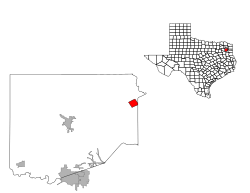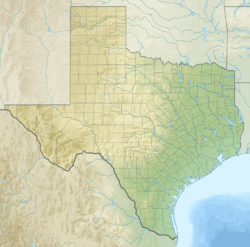Ore City, Texas facts for kids
Quick facts for kids
Ore City, Texas
|
|
|---|---|
| Nicknames:
"City on the Iron Hill", “Iron City”, OC
|
|
 |
|
| Country | United States |
| State | Texas |
| County | Upshur |
| Incorporated | 1951 |
| Founded by | Lewis Porter Featherstone |
| Named for | the iron discovered |
| Government | |
| • Type | Strong Mayor-council |
| Area | |
| • Total | 2.18 sq mi (5.65 km2) |
| • Land | 2.16 sq mi (5.59 km2) |
| • Water | 0.02 sq mi (0.06 km2) |
| Elevation | 308 ft (94 m) |
| Population
(2020)
|
|
| • Total | 1,108 |
| • Density | 568.52/sq mi (219.56/km2) |
| Demonym(s) | Ore Citian |
| Time zone | Central (CST) |
| ZIP code |
75683
|
| Area code(s) | 903, 430 |
| FIPS code | 48-54216 |
| GNIS feature ID | 2411331 |
| Major highways | |
Ore City is a city in Upshur County, Texas, United States. Located where US 259 and FM 450 converge, just four miles below the Lake O’ the Pines. The population was 1,108 at the 2020 census.
Contents
Geography
Ore City is situated about 13 miles northeast of Gilmer at the junction of U.S. Highway 259 and FM 450. 20 miles north of Longview, Texas.
Four miles north of Ore City is Lake O' the Pines
Ore City is part of a larger area known as the East Texas, Piney Woods. The city and the surrounding area boast a number of impressive specimens.
According to the United States Census Bureau, the city has a total area of 2.3 mi2 (5.9 km2), of which 2.3 mi2 (5.9 km2) are land and 0.04 mi2 (0.1 km2) (0.88%) is water.
Major highways
History
Before any settlement the indigenous Caddo were the dominant people living within the region and on the land.
The arrival of European settlers in the 18th and 19th centuries led to significant changes in the region, including the removal of these Indigenous peoples.
Originally part of the William Murray League, the area was first settled in the early 1850s by a group from Haywood County, Tennessee. They immediately started The Murray League Methodist Episcopal Church, South as well as the Murray League Institute. After the Civil War, rich iron ore deposits were discovered in the area and ore was mined sporadically from the 1860s through 1900.
Around 1910, a commercial company led by Colonel L.P. Featherstone was formed to mine ore in the East Texas Iron Ore Belt. He persuaded the Santa Fe Railway line to finance a rail link with Port Bolivar. Land for a new city was purchased and platted into streets and lots around 1911. The town was given the name Ore City and a post office was established soon after. By 1914, 30 miles of the line known as the Port Bolivar Iron Ore Railway had been built, connecting Ore City with Longview. The newly founded community had an estimated population of 400. Further construction on the railroad line was halted by the outbreak of World War I. Colonel Featherstone's company went into bankruptcy and the rail line was abandoned in 1927. Ore City survived and by 1936, around 500 people lived in the community. During World War II, the federal government built a steel plant 10 miles north of Ore City to mine the same ore that previously brought Colonel Featherstone to the area. The plant was completed just as the war ended and was sold to a Texas group as surplus property. They operated it as the Lone Star Steel Company.
Ore City was incorporated in 1951. At that time, the number of residents had fallen to 385.
Growth resumed in the mid-1960s and by 1976, Ore City had a population of 900, with 34 businesses operating in the city. More than 1,000 people lived in the city by the year 2000.
Decline and Stabilization
As with many other mining-based towns, the depletion of resources led to a decline in population and economic activity over time. By the mid-20th century, mining operations had slowed considerably, and Ore City's growth stabilized as a small, rural community, falling short of becoming a potential Boomtown.
Demographics
| Historical population | |||
|---|---|---|---|
| Census | Pop. | %± | |
| 1960 | 819 | — | |
| 1970 | 830 | 1.3% | |
| 1980 | 1,050 | 26.5% | |
| 1990 | 898 | −14.5% | |
| 2000 | 1,106 | 23.2% | |
| 2010 | 1,144 | 3.4% | |
| 2020 | 1,108 | −3.1% | |
| U.S. Decennial Census | |||
| Race | Number | Percentage |
|---|---|---|
| White (NH) | 758 | 68.41% |
| Black or African American (NH) | 67 | 6.05% |
| Native American or Alaska Native (NH) | 20 | 1.81% |
| Asian (NH) | 6 | 0.54% |
| Mixed/Multi-Racial (NH) | 66 | 5.96% |
| Hispanic or Latino | 191 | 17.24% |
| Total | 1,108 |
As of the 2020 United States census, there were 1,106 people, 350 households, and 252 families residing in the city.
Twenty years earlier, in the census of 2000, 1,106 people, 403 households, and 295 families resided there. At that time the population density was 490.4 inhabitants per square mile (189.3/km2). The 432 housing units averaged 191.5 per square mile (73.8/km2). The racial makeup of the city was predominantly White, comprising 68.41% of the population. Black or African Americans made up 6.05%, while Native Americans or Alaska Natives accounted for 1.81%. Asians represented 0.54%, and those identifying as Mixed or Multiracial constituted 5.96%. Additionally, Hispanic or Latino individuals comprised 17.24% of the population.
Of the 403 households, 37.2% had children under the age of 18 living with them, 57.3% were married couples living together, 13.4% had a female householder with no husband present, and 26.6% were not families. About 22.6% of all households were made up of individuals, and 10.9% had someone living alone who was 65 years of age or older. The average household size was 2.74 and the average family size was 3.23. In the city, the population was distributed as 31.8% under the age of 18, 8.7% from 18 to 24, 28.0% from 25 to 44, 18.1% from 45 to 64, and 13.4% who were 65 years of age or older. The median age was 32 years. For every 100 females, there were 89.1 males. For every 100 females age 18 and over, there were 86.6 males. The median income for a household in the city was $33,542, and for a family was $37,750. Males had a median income of $28,250 versus $18,333 for females. The per capita income for the city was $15,997. About 17.2% of families and 22.4% of the population were below the poverty line, including 32.5% of those under age 18 and 18.0% of those age 65 or over.
Sports
Battle of 259
Ore City's rivalry game with Diana
Economy
Ore City, Texas, part of the Longview metropolitan area, has an economy that's traditionally tied to its small-town roots in agriculture, timber, and tourism related to nearby Lake O' the Pines. Located in East Texas and near the more developed regions of Longview and Marshall, Ore City is relatively modest in scale and maintains a completely rural economic profile. It doesn't experience the kind of industrial or tech-driven growth seen in larger Texas cities but is more reliant on local businesses, agriculture, and nearby employment centers.
During the iron boom in the late 19th and early 20th centuries, Ore City had a prime opportunity to diversify its economy but ultimately struggled to do so. The town's economy relied heavily on the iron industry, and when iron ore was discovered nearby, it led to a surge of mining and related activities. However, this boom didn't last long, and local economic strategies were almost solely focused on exploiting this one resource, with limited investment in other sectors like infrastructure, services, or secondary industries that could support long-term economic stability.
One major issue was that Ore City lacked the transportation and logistics infrastructure that could have supported broader industrial diversification. Without significant rail connections or investment in better roads, it was challenging to attract new industries to the area. As a result, when the iron ore deposits began to dwindle or became too costly to extract, the town found itself with limited economic fallback options.
Furthermore, the town's reliance on iron prevented it from developing the agricultural or manufacturing industries that nearby regions were investing in. Many residents, whose livelihoods depended on mining, faced unemployment and hardship as demand for local iron faded. Without significant efforts to diversify, Ore City was left vulnerable to economic downturns, a trend that continues to impact its economic development today.
Education
Ore City and the surrounding area is served by the Ore City Independent School District.
Media
Radio
KAZE (106.9) plays Hip-Hop
Notable people
- Chubby Grigg, professional football player, businessman
- Montana Jordan, TV actor
- Walter McAfee, astronomer and physicist
- Chad Stanley, professional football player
See also
 In Spanish: Ore City (Texas) para niños
In Spanish: Ore City (Texas) para niños




